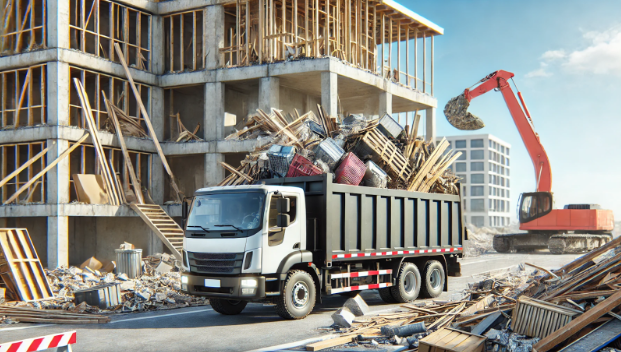
The Complete Guide to Construction Debris Removal: Simplify Your Site Cleanup
Construction projects can be exciting, but they also generate a massive amount of debris. From concrete and metal scraps to hazardous materials, the cleanup process is essential for keeping sites safe and compliant. In this guide, we’ll walk you through the ins and outs of construction debris removal, providing step-by-step tips, safety advice, and disposal methods. Let’s dive in and make your next cleanup project as smooth as possible.
1. Understanding Construction Debris: What It Includes and Why It Matters
Construction debris includes a range of materials left over from building or demolition projects. Common types of construction waste include:
- Concrete and Asphalt: Found in most demolition projects.
- Wood: Leftover from framing, floors, and walls.
- Metals: Steel, copper, and aluminum often used in plumbing, wiring, and framing.
- Insulation and Drywall: Common in residential and commercial projects.
- Hazardous Waste: Paint, adhesives, or treated wood requiring special disposal.
- Why It Matters: Proper debris management is crucial for environmental protection and workplace safety. Construction sites that ignore waste management can face legal fines, increased safety risks, and negative environmental impacts.
2. Planning for Debris Removal
Early Planning:
Integrate waste management into your project plan from day one. A clear plan not only saves time but also helps control costs and ensures that waste is disposed of legally and sustainably.
Key Steps for Effective Planning:
- Estimate Waste Types and Volumes: Identify the types of debris you’ll encounter and estimate the quantities.
- Choose the Right Equipment: Dumpsters, waste containers, and hauling vehicles make cleanup efficient.
- Determine Disposal Methods: Research local regulations on recycling and hazardous waste disposal.
- Create a Waste Management Schedule: Organize waste removal at different project stages to avoid clutter and manage logistics.
3. Best Practices for On-Site Debris Management
Maintaining an organized and clean site improves safety and efficiency. Follow these best practices:
- Set Up a Waste Sorting System: Designate specific areas for different types of debris, like wood, metal, and general waste.
- Use Signage: Clearly mark waste disposal and recycling areas to prevent confusion.
- Train Your Team: Ensure everyone knows the procedures and safety protocols for waste management.
- Schedule Regular Cleanups: Regular cleanup intervals prevent waste buildup, making the site safer and more manageable.
4. Choosing the Right Containers for Construction Debris
Selecting suitable containers is crucial. Consider these options based on the type and volume of waste:
| Type of Container | Ideal For | Capacity Range |
|---|---|---|
| Roll-Off Dumpsters | Large volumes of mixed debris | 10-40 cubic yards |
| Dump Trailers | Versatile for various waste types | 10-20 cubic yards |
| Specialized Bins | For metal, concrete, or asphalt | Varies based on material |
| Compacting Containers | High volume, minimal space | Up to 30 cubic yards |
5. Recycling and Reusing Construction Materials
Construction sites can be environmentally friendly by incorporating recycling and reuse strategies. Not only is this approach sustainable, but it may also reduce waste disposal costs.
Materials Commonly Recycled in Construction Projects:
- Concrete and Asphalt: Reused as aggregate for new pavement.
- Metals: Steel and aluminum are highly recyclable, and recycling them is cost-effective.
- Wood: Untreated wood can be repurposed or mulched.
- Bricks and Masonry: Crushed for new construction or landscaping.
- Pro Tip: Always check with local recycling facilities to understand what materials they accept and the preparation required.
6. Handling Hazardous Materials: Safety First
Certain construction materials require special handling due to potential hazards. Examples include asbestos, lead-based paint, and chemically treated wood.
Safety Tips for Handling Hazardous Construction Waste:
- Identify Hazardous Waste: Understand the materials on your site that could pose a risk.
- Equip Workers with Protective Gear: Gloves, masks, and eye protection are essential.
- Hire Professionals for Hazardous Waste: If in doubt, hire certified hazardous waste removal services to handle the disposal.
Improper handling of hazardous materials can lead to serious health risks and legal consequences, so take this aspect of waste management seriously.
Frequently Asked Questions (FAQs)
Q: What is the average cost of construction debris removal?
Costs vary depending on location, debris type, and disposal methods but generally range from $200 to $800 per dumpster rental.
Q: Can construction debris be recycled?
Yes, materials like concrete, metals, and untreated wood can often be recycled.
Q: How do I know if I need a permit for debris removal?
Permit requirements vary by region. Check with local authorities to ensure compliance with regulations.
Q: What are the most common hazards in construction debris?
Asbestos, lead-based paint, and chemically treated wood are among the hazardous materials found in construction waste.
Q: How often should I schedule waste removal on a construction site?
The frequency depends on project size, but a weekly or bi-weekly schedule works well for most construction sites.

